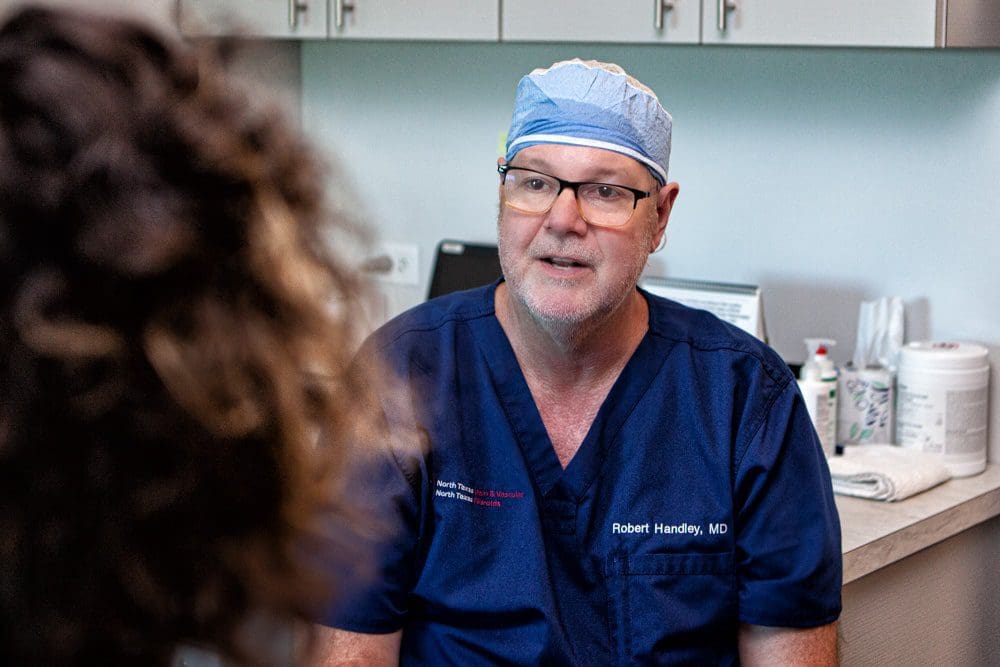Non-Surgical Treatment for Uterine Fibroids
Dr. Handley at North Texas Fibroids is an experienced Interventional Radiologist who has a team of highly trained fibroid specialists. If you’re interested in Uterine Fibroid Embolization or UFE treatment in the Dallas-Fort Worth, TX, area, contact us today to schedule an appointment. Call North Texas Fibroids at (972) 640-9720 or schedule an appointment online.


UFE Treatment
Once you and your doctors(s) have determined that Uterine Fibroid Embolization (UFE) is the right fibroid treatment option for you, here are some of the things you’ll need to know before, during and after treatment.
Before Treatment
Your Interventional Radiologist (IR) will explain to you in detail all of the pre-procedure tests prescribed. Also during your consult, you should let your doctor know if you are allergic to any medications, shellfish, iodine, contrast agents, or gelatin to minimize the risk of a reaction as a result of the fibroid treatment procedure. You and your doctor also should decide what type of sedation will work best for you. Most doctors use conscious sedation, which means you will be awake during the procedure but you will feel groggy.
UFE is performed as an outpatient fibroid treatment procedure at our center in Flower Mound. After you arrive, you will be prepped for the procedure by our Radiology staff. This includes initiating the sedation and other medication discussed during your consult. Other medications to help manage post-procedure effects may also be administered at this time. It is important to discuss with your IR which medications will be used in the management of your post-procedure care. Once you feel groggy or sleepy, you will be moved to the Radiology Suite, where the fibroid treatment will be performed.


UFE Treatment
Uterine fibroid embolization, also known as uterine artery embolization is a minimally invasive procedure that is performed by an Interventional Radiologist (IR), a medical doctor with extensive experience in minimally invasive procedures. Prior to the procedure, some tests may have to be done. The entire fibroid treatment typically lasts less than one hour, and is performed as an outpatient therapy. Patients usually stay in our recovery suite for two hours after the procedure is complete.
The uterine fibroid embolization procedure begins with a tiny incision in the femoral artery. This incision provides the IR with access to the femoral artery in the upper thigh. Using specialized X-ray equipment, the IR passes a catheter (small tube) into the femoral artery, to the uterine artery, and guides it near the location of the fibroid tumor. When the IR has reached the location of the fibroids, embolic material (small spheres) are injected through the catheter and into the blood flow leading to the uterine fibroid tumors.
The embolic material is designed to block the vessels around the fibroid, depriving it of the blood and oxygen it needs to grow. The blood and oxygen deprivation results in fibroids shrinking. The embolic material remains permanently in the blood vessels at the fibroid site.
The catheter is then moved to the other side of the uterus, usually using the same incision in the thigh. Once the IR has completed embolization of the uterine artery on both sides, the catheter is gently removed and the IR places finger pressure over the small incision in your thigh. After holding the puncture site for a few minutes to help stop any bleeding, the IR may close the incision using a vascular closure device.
After the procedure, you may experience some discomfort such as abdominal cramping or pain. You and your doctor will determine what medications may be needed to keep you comfortable. The post-procedure care that you receive will be administered by skilled nurses and your IR. Post procedure appointments will need to be scheduled, and since these appointments vary, be sure to ask your IR when they need to be scheduled.
After Treatment
Most women experience some degree of abdominal pain or cramping (similar to menstrual cramps) shortly after this treatment for uterine fibroids. Your doctor will decide what medications you will need to keep you comfortable. Generally patients receive medications for pain management. Occasionally a patient experiences fever, which is usually treated with medication. Some patients experience nausea related to medications and they can be changed accordingly. You will remain in an observation unit up to 3 hours, depending upon the decision of your physician.
Some patients may experience “post-embolization syndrome” following the uterine fibroid treatment which is described as having flu-like symptoms, such as a low grade fever, malaise (a vague feeling of discomfort), and mild nausea. Post-embolization syndrome can occur within a few hours or up to a few days after uterine fibroid embolization.
Once your IR has evaluated you and has decided you are ready for discharge, you will receive discharge instructions from your doctor. These instructions include information on post uterine fibroid treatment care regarding medications you will need to take to keep you comfortable based on how you are feeling. They may also include information on when you can expect to begin returning to normal activities, as well as all phone numbers for whom to call if you have questions. You may continue to experience some cramping, similar to menstrual period cramping, that lasts a few days after the procedure. Most women are able to return to light activity within a few days of the uterine fibroid embolization treatment and are usually back to work and normal activity on average, within 11 days.
Finally, your IR will schedule your post-procedure appointments to check your recovery. Typical timeframes for these appointments are one week post-procedure, and three months post-procedure. Since follow up appointments do vary, be sure to ask when these appointments should be scheduled.
UFE Treatment in the Dallas-Fort Worth Area
If you have been diagnosed with Uterine Fibroids, contact Dr. Handley and his team at North Texas Fibroids to learn more about Uterine Fibroid Embolization. We specialize in this minimally invasive procedure to treat uterine fibroids. Schedule an appointment at our Flower Mound office to discuss any questions you may have.
Steps to Treatment
If you feel UFE might be the right treatment option for you then please follow these steps:
Conduct research on the Internet or at the library on which uterine fibroid treatments are appropriate for you. Visit websites such as the National Uterine Fibroid Foundation, American Congress of Obstetricians and Gynecologists, or the Society of Interventional Radiology which has an entire section on uterine fibroid embolization.
Your OB-GYN is a physician specialist who provides medical and surgical care to women and has particular expertise in pregnancy, childbirth, and disorders of the reproductive system. Your OB-GYN will help you understand more about fibroids and the related symptoms. They will also inform you of all available fibroid treatment options.
- Obtain a complete copy of your medical records from your current OB-GYN and do not hesitate to discuss treatment options with other doctors.
- Keep talking until you are comfortable with what you hear. You and your doctor should both be satisfied with your treatment plan.
- Come to talk to us. We specialize in uterine fibroid embolization and we’ll be able to help determine if you are a good candidate for UFE.
- Try to identify and speak with women who have had treatments for their uterine fibroids to learn about their individual experiences.
- Discuss alternatives with your doctor so he/she knows you are aware of them and to see if you are a potential candidate for UFE.
- Many hospitals have women’s health seminars that feature a discussion on fibroids.
Give us a call at the number listed above. We would be happy to discuss if you are a good candidate for UFE. Here are some questions you might think about asking us:
- Please explain how you would coordinate my care with my OB-GYN.
- Which OB-GYNs referred you for UFE?
- How often is the procedure successful in treating uterine fibroids?
- Are your patients happy with the procedure?
- How often do complications occur? What are typical complications?
- How will I feel during and after the UFE procedure?
- How long should I expect to be away from work?
- What is the length of the procedure? What is the normal recovery time?
- How long should I expect to stay in the hospital?
- What kind of follow-up care is typical and who manages it?
- What typically happens to the fibroids after the blood supply is cut off? Should I expect them to be expelled vaginally or will the procedure simply result in my fibroids shrinking?
- Will my fibroids, or the symptoms of my fibroids, come back?
- Will I still get my periods after having UFE and what will they be like?
- Will my insurance cover uterine fibroid embolization?
Financing Information For UFE
- Call to confirm your insurance covers UFE treatment
- Information about CareCredit: a healthcare credit card

